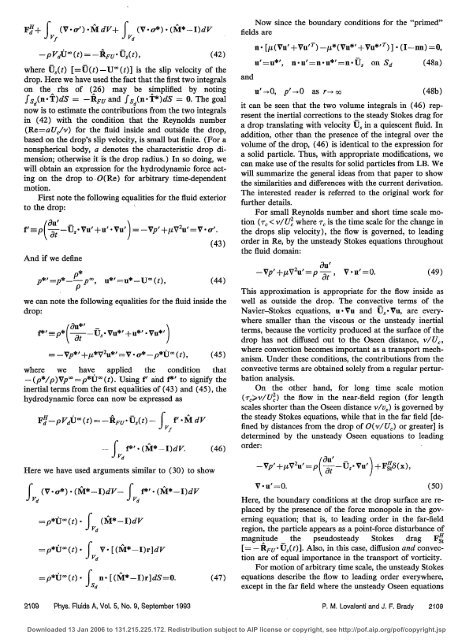The force on a bubble, drop, or particle in arbitrary time-dependent ...
The force on a bubble, drop, or particle in arbitrary time-dependent ...
The force on a bubble, drop, or particle in arbitrary time-dependent ...
You also want an ePaper? Increase the reach of your titles
YUMPU automatically turns print PDFs into web optimized ePapers that Google loves.
T*)dS<br />
J'+ VfJV,')-lV fVd Vt* 9*I<br />
-PVduWJ (t = -RFU*- QU~), (42)<br />
where Us(t) [=U(t)-U'(t)] is the slip velocity of the<br />
<strong>drop</strong>. Here we have used the fact that the first two <strong>in</strong>tegrals<br />
<strong>on</strong> the rhs of (26) may be simplified by not<strong>in</strong>g<br />
fsd(nT)dS = -RFU and Sfd(n * = 0. <str<strong>on</strong>g>The</str<strong>on</strong>g> goal<br />
now is to estimate the c<strong>on</strong>tributi<strong>on</strong>s from the two <strong>in</strong>tegrals<br />
<strong>in</strong> (42) with the c<strong>on</strong>diti<strong>on</strong> that the Reynolds number<br />
(Re=aU/v) f<strong>or</strong> the fluid <strong>in</strong>side and outside the <strong>drop</strong>,<br />
based <strong>on</strong> the <strong>drop</strong>'s slip velocity, is small but f<strong>in</strong>ite. (F<strong>or</strong> a<br />
n<strong>on</strong>spherical body, a denotes the characteristic <strong>drop</strong> dimensi<strong>on</strong>;<br />
otherwise it is the <strong>drop</strong> radius.) In so do<strong>in</strong>g, we<br />
will obta<strong>in</strong> an expressi<strong>on</strong> f<strong>or</strong> the hydrodynamic <str<strong>on</strong>g>f<strong>or</strong>ce</str<strong>on</strong>g> act<strong>in</strong>g<br />
<strong>on</strong> the <strong>drop</strong> to O(Re) f<strong>or</strong> <strong>arbitrary</strong> <strong>time</strong>-<strong>dependent</strong><br />
moti<strong>on</strong>.<br />
First note the follow<strong>in</strong>g equalities f<strong>or</strong> the fluid exteri<strong>or</strong><br />
to the <strong>drop</strong>:<br />
-A-U5-Vu'+u' -VU') =-Vp'-V<br />
And if we def<strong>in</strong>e<br />
Pa<br />
2 u'=V a'.<br />
(43)<br />
we can note the follow<strong>in</strong>g equalities f<strong>or</strong> the fluid <strong>in</strong>side the<br />
<strong>drop</strong>:<br />
* **(a1u*' Vu*±* .*)<br />
=-vp*t +,*v2u*' =V O,*-p*U-, H-<br />
(45)<br />
where we have applied the c<strong>on</strong>diti<strong>on</strong> that<br />
-(p*/p)VpO =p*Uw (t). Us<strong>in</strong>g f' and f*' to signify the<br />
<strong>in</strong>ertial terms from the first equalities of (43) and (45), the<br />
hydrodynamic <str<strong>on</strong>g>f<strong>or</strong>ce</str<strong>on</strong>g> can now be expressed as<br />
FRj-pVdU''(t)=-RFU (t)- ff *MdV<br />
Vf<br />
fVd f*' (M* -)dV. (46)<br />
Here we have used arguments similar to (30) to show<br />
Now s<strong>in</strong>ce the boundary c<strong>on</strong>diti<strong>on</strong>s f<strong>or</strong> the "primed"<br />
fields are<br />
and<br />
n. [[L(Vu'+Vu' Ț ) _*(Vu*t+Vu*, T )] * (I-nn) =0,<br />
u =u*', n-'nu*= J <strong>on</strong> Sd<br />
(48a)<br />
u'-0, p'-*O as r-,co (48b)<br />
it can be seen that the two volume <strong>in</strong>tegrals <strong>in</strong> (46) represent<br />
the <strong>in</strong>ertial c<strong>or</strong>recti<strong>on</strong>s to the steady Stokes drag f<strong>or</strong><br />
a <strong>drop</strong> translat<strong>in</strong>g with velocity Us <strong>in</strong> a quiescent fluid. In<br />
additi<strong>on</strong>, other than the presence of the <strong>in</strong>tegral over the<br />
volume of the <strong>drop</strong>, (46) is identical to the expressi<strong>on</strong> f<strong>or</strong><br />
a solid <strong>particle</strong>. Thus, with appropriate modificati<strong>on</strong>s, we<br />
can make use of the results f<strong>or</strong> solid <strong>particle</strong>s from LB. We<br />
will summarize the general ideas from that paper to show<br />
the similarities and differences with the current derivati<strong>on</strong>.<br />
<str<strong>on</strong>g>The</str<strong>on</strong>g> <strong>in</strong>terested reader is referred to the <strong>or</strong>ig<strong>in</strong>al w<strong>or</strong>k f<strong>or</strong><br />
further details.<br />
F<strong>or</strong> small Reynolds number and sh<strong>or</strong>t <strong>time</strong> scale moti<strong>on</strong><br />
(i-s < v/U,2 where r, is the <strong>time</strong> scale f<strong>or</strong> the change <strong>in</strong><br />
the <strong>drop</strong>s slip velocity), the flow is governed, to lead<strong>in</strong>g<br />
<strong>or</strong>der <strong>in</strong> Re, by the unsteady Stokes equati<strong>on</strong>s throughout<br />
the fluid doma<strong>in</strong>:<br />
au'<br />
This approximati<strong>on</strong> is appropriate f<strong>or</strong> the flow <strong>in</strong>side as<br />
well as outside the <strong>drop</strong>. <str<strong>on</strong>g>The</str<strong>on</strong>g> c<strong>on</strong>vective terms of the<br />
Navier-Stokes equati<strong>on</strong>s, u* Vu and Us- Vu, are everywhere<br />
smaller than the viscous <strong>or</strong> the unsteady <strong>in</strong>ertial<br />
terms, because the v<strong>or</strong>ticity produced at the surface of the<br />
<strong>drop</strong> has not diffused out to the Oseen distance, vIUc,<br />
where c<strong>on</strong>vecti<strong>on</strong> becomes imp<strong>or</strong>tant as a transp<strong>or</strong>t mechanism.<br />
Under these c<strong>on</strong>diti<strong>on</strong>s, the c<strong>on</strong>tributi<strong>on</strong>s from the<br />
c<strong>on</strong>vective terms are obta<strong>in</strong>ed solely from a regular perturbati<strong>on</strong><br />
analysis.<br />
On the other hand, f<strong>or</strong> l<strong>on</strong>g <strong>time</strong> scale moti<strong>on</strong><br />
(r->v/U2) the flow <strong>in</strong> the near-field regi<strong>on</strong> (f<strong>or</strong> length<br />
scales sh<strong>or</strong>ter than the Oseen distance v/vc) is governed by<br />
the steady Stokes equati<strong>on</strong>s, while that <strong>in</strong> the far field [def<strong>in</strong>ed<br />
by distances from the <strong>drop</strong> of O(v/Uc) <strong>or</strong> greater] is<br />
determ<strong>in</strong>ed by the unsteady Oseen equati<strong>on</strong>s to lead<strong>in</strong>g<br />
<strong>or</strong>der:<br />
-Vp' +tV~uI~(-j 7 -U. CVu') +F 't8(X),<br />
(49)<br />
.fVd(V-a-*)<br />
(Ml*-~I)dV- f~df*t. (M1*1)dV<br />
= P*toQ(t) .J~ (MA*-I)dV<br />
= P*to (t). TfV V [(M1*-I)r~dV<br />
~P*iOO (t). .fSd n-[(1M*-I)r~dS=0.<br />
2109 Phys. Fluids A, Vol. 5, No. 9, September 1993<br />
V -u'= O. (50)<br />
Here, the boundary c<strong>on</strong>diti<strong>on</strong>s at the <strong>drop</strong> surface are replaced<br />
by the presence of the <str<strong>on</strong>g>f<strong>or</strong>ce</str<strong>on</strong>g> m<strong>on</strong>opole <strong>in</strong> the govern<strong>in</strong>g<br />
equati<strong>on</strong>; that is, to lead<strong>in</strong>g <strong>or</strong>der <strong>in</strong> the far-field<br />
regi<strong>on</strong>, the <strong>particle</strong> appears as a po<strong>in</strong>t-<str<strong>on</strong>g>f<strong>or</strong>ce</str<strong>on</strong>g> disturbance of<br />
magnitude the pseudosteady Stokes drag FIS<br />
[= -R k, UJ(t)]. Also, <strong>in</strong> this case, diffusi<strong>on</strong> and c<strong>on</strong>vecti<strong>on</strong><br />
are of equal imp<strong>or</strong>tance <strong>in</strong> the transp<strong>or</strong>t of v<strong>or</strong>ticity.<br />
F<strong>or</strong> moti<strong>on</strong> of <strong>arbitrary</strong> <strong>time</strong> scale, the unsteady Stokes<br />
(47) equati<strong>on</strong>s describe the flow to lead<strong>in</strong>g <strong>or</strong>der everywhere,<br />
except <strong>in</strong> the far field where the unsteady Oseen equati<strong>on</strong>s<br />
P. M. Lovalenti and J. F. Brady 2109<br />
Downloaded 13 Jan 2006 to 131.215.225.172. Redistributi<strong>on</strong> subject to AIP license <strong>or</strong> copyright, see http://pof.aip.<strong>or</strong>g/pof/copyright.jsp
















